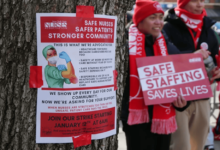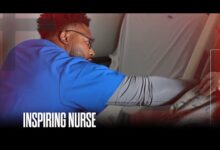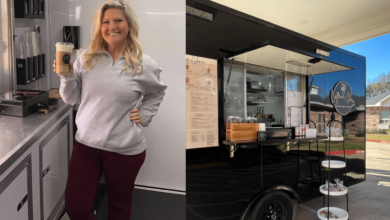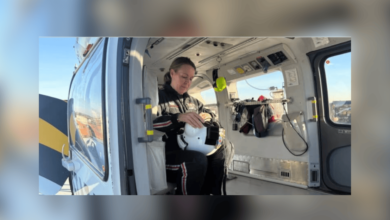New critical care nursing leader vows to protect speciality

Staffing ratios, erosion of roles and transgender rights are all on the priority list for the new head of a national organisation that represents critical care nurses. He has spoken to Nursing Times about the biggest challenges facing the specialty, as the annual winter spike in seriously ill patients looms.
Ian Naldrett, a nurse of 15 years, was appointed in September as chair of the British Association of Critical Care Nurses (BACCN), replacing Nicki Credland, who was a leading voice for nursing during the Covid-19 pandemic.
As Mr Naldrett steps into the leadership role, the NHS is going into what is anticipated to be a difficult winter.
A recent report by NHS Providers found 95% of trust leaders were “extremely or moderately concerned” about upcoming seasonal pressures, with 80% expecting this winter to be trickier than the last.
But, the new BACCN chair explained, winter was only part of the story – and only part of his priorities.
He said he would advocate for safer staffing all year round, the protection of critical care nursing as a specialty, and the breaking of “norms” from Covid-19, which had meant working under unbearable pressure had become viewed as part of the job.
Speaking about his chief priority, Mr Naldrett said: “There has to be a renewed focus on staffing because we have significant challenges in many critical care units across the country.”
He aired concerns for winter, but said this was because the “lull” that critical care would typically experience across the rest of the year had not materialised due, in part, to Covid-19 and other respiratory illnesses.
“It was not overwhelming [in summer], but it’s been busy and that concerns me for winter,” he added.
“There is a prevalence [of Covid-19], but also other respiratory illnesses. It’s no longer a winter crisis, it’s a crisis-crisis. We’ve seen sustained pressure.”
He cited a consistent difficulty in critical care to step patients down, due to low capacity in general wards, itself due to social care capacity issues. This meant intensive care units were often operating at maximum capacity even outside of the winter months.
Mr Naldrett said patients sometimes spent the better part of a week in critical care, even if they had long been stabilised.
“There are no ward beds,” he said. “It’s almost comical; we have patients walking around intensive care opposite a ventilated patient, waiting to the point we’ve discharged people because they’ve done their ward period with us.
“My concern, rather than a surge of sick patients, is that we can’t get people out of the other end, which is really bad for patient experience and safety.”
There was a feeling among the workforce that, despite the Covid-19 emergency period being long over, conditions inside intensive care had not reflected this, he said.
“We’ve been in critical condition for a significant period of time now,” said Mr Naldrett.
“We’ve reduced transfer times, which we were not doing so well, but the response when we reduce our load is to quickly cut beds as soon as we are not at maximum capacity.
“This approach is short-sighted, because critical care units work when you have flexibility in staffing and the number of patients you can care for safely. If you’re working at 100% capacity all the time, it’s not a safe model of care.”
“We must preserve what it is to be a nurse. Nursing in and of itself is a profession, and I’m proud to use that title”
Ian Naldrett
He said it would be “naïve” to think things could easily go back to the way they were before March 2020, but that he aimed to help restore working conditions for nurses – and care conditions for patients.
“Covid was such a monumental step outside the comfort zone, with all the horrendous things that happened in critical care during that time,” he said.
“There are things which can grow out of it. Our flexibility is different, but the risk is we might lose things we did well before Covid. For example, we provided expert patient and family-centred care.
“That went on pause a lot in Covid and I haven’t fully seen that restored. It’s something I want to work on at BACCN.”
Another thing that Mr Naldrett said was yet to fully recover following the pandemic was staffing ratios.
National standards for critical care say there should be a nurse-to-patient ratio of at least 1:1 for ventilated patients and 1:2 for others. However, during the height of Covid-19, these were diluted.
Mr Naldrett said he, as BACCN chair, would “keep pushing the envelope” for the restoration of better staffing ratios, which reflect what the evidence says is best.
He added: “We are not just machine operators, we need time to spend with families and patients, do things outside of changing ventilator settings.
“If you’re just doing that, you could look after three or four people at once. But [critical care nurses] value a patient-centred approach and that requires a higher ratio of staff.”
All of this, Mr Naldrett said, came back to protecting the integrity of critical care as a field of nursing.
He said critical care nursing was being degraded due to budgetary pressures on trusts, the normalisation of emergency pressures in intensive care – and a phenomenon he referred to as “role creep”.
In some trusts, critical care nurses had been deployed elsewhere when intensive care was not full.
Mr Naldrett said this put the nurses outside of their comfort zone and meant they were not making use of their specialty.
The BACCN chair added that this went against the principle of ensuring nurses worked to the top of their licence, and also had a negative impact on retention.
“I’ve seen a massive increase [in redeployment],” he said. “I wouldn’t blame hospital trusts for doing it, but it’s important to point out the reverse: you couldn’t bring in a nurse from another specialty and leave them in critical care, they would have to be heavily supported.”
Mr Naldrett described a “normality” of redeploying staff in a pinch, which arose from the Covid-19 emergency period, which he said must be broken.
“We have to reset it to an evidence-based approach for patient care, rather than what works for your chief financial officer; it’s not sustainable,” he said, and suggested BACCN would advocate for safe and sustainable staffing – which would include ensuring nurses can work in their chosen specialty.
“The embodiment of critical care nursing is looking after the physical health, social health, emotional and family health. We don’t just operate machines”
Ian Naldrett
Mr Naldrett also raised the issue of “role creep” when discussing his concerns about the erosion of the specialty, explaining that in some hospital trusts staff who were not registered nurses had been drafted in to fill gaps or take on roles usually performed by critical care nursing staff.
“We’ve seen influxes of people wanting to do intensive care nursing courses from other professions, which I don’t have an issue with itself. But it risks suggesting that the duties we perform are generic and not specific to nursing – they are,” said Mr Naldrett.
“I can perform some aspects of mobilising patients, but I’d never call myself a physiotherapist. I’m concerned we have people external to nursing asking: does this role need to be a nurse? Can someone do it who is from another profession?”
He added: “We must preserve what it is to be a nurse. Nursing in and of itself is a profession, and I’m proud to use that title and it’s something we should celebrate.
“The embodiment of critical care nursing is looking after the physical health, social health, emotional and family health. We don’t just operate machines.”
As a member of the LGBTQ+ community himself, Mr Naldrett said a personal priority as chair was to recognise the importance of inclusivity in critical care nursing.
“We’ve already started a project to look at how we can be more inclusive to our members,” he said.
As well as inclusivity within the workforce, Mr Naldrett said the same must be done for patients, particularly transgender patients and those who are admitted to intensive care with learning disabilities.
On the former, Mr Naldrett said he was “disappointed” with recent suggestions from the Conservative Party that it wanted to prohibit trans patients from being cared for on wards designated to their chosen, not birth-assigned, gender.
Mr Naldrett said that while this change would not impact critical care directly, as these units do not tend to be segregated by sex, it resurfaced the issue of trans healthcare equity.
In situations where patients are critically ill, Mr Naldrett argued that it was even more important to get care right.
He recalled an incident a few years ago on a critical care unit where a patient, who was a trans woman, was misgendered in the hospital computer system. After this, changes were made to try and ensure it never happened again.
“If you are in critical care, it means you might die. Patients there are facing their own mortality, often for the first time, and we don’t deeply sedate people half as much as we used to – so imagine taking all that on whilst also being misgendered and experiencing gender dysphoria,” said Mr Naldrett.
He added: “We talk about how we can make sure nursing is sensitive, and it’s all linked and goes back to patient-centred care.”







